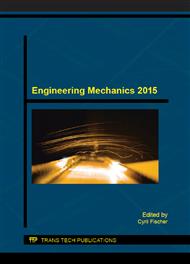p.555
p.563
p.571
p.579
p.585
p.591
p.601
p.608
p.614
Evaluation of Fracture Tests of Concrete Specimens via Advanced Tool for Experimental Data Processing
Abstract:
Cement-based composites are traditionally used building materials. Concrete is the basic representative of this type of materials which exhibit the so called quasi-brittle response. Quantification of mechanical fracture parameters is performed using fracture tests on specimens with a stress concentrator. Load versus crack mouth opening displacement (P–CMOD) diagrams are recorded during these tests. In order to correctly evaluate these diagrams, an advanced own developed software tool was used for the data filtering and appropriate modifications. In this paper, the programmed Java utility is generally introduced and its utilization demonstrated on the set of recorded P–CMOD diagrams, which are further evaluated using Double-K fracture model.
Info:
Periodical:
Pages:
585-590
Citation:
Online since:
January 2016
Price:
Сopyright:
© 2016 Trans Tech Publications Ltd. All Rights Reserved
Share:
Citation:


